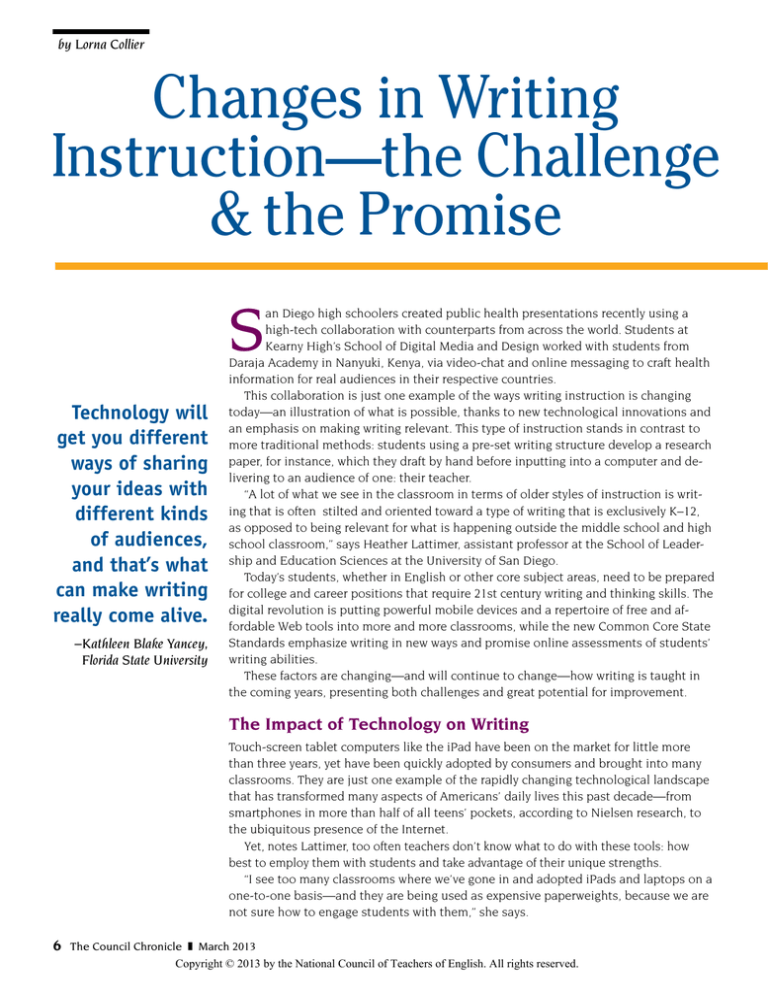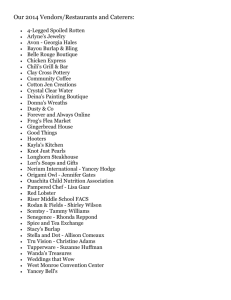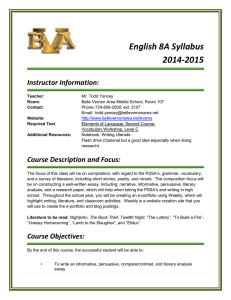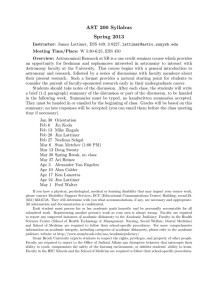
by Lorna Collier
Changes in Writing
Instruction—the Challenge
& the Promise
S
Technology will
get you different
ways of sharing
your ideas with
different kinds
of audiences,
and that’s what
can make writing
really come alive.
–Kathleen Blake Yancey,
Florida State University
an Diego high schoolers created public health presentations recently using a
high-tech collaboration with counterparts from across the world. Students at
Kearny High’s School of Digital Media and Design worked with students from
Daraja Academy in Nanyuki, Kenya, via video-chat and online messaging to craft health
information for real audiences in their respective countries.
This collaboration is just one example of the ways writing instruction is changing
today—an illustration of what is possible, thanks to new technological innovations and
an emphasis on making writing relevant. This type of instruction stands in contrast to
more traditional methods: students using a pre-set writing structure develop a research
paper, for instance, which they draft by hand before inputting into a computer and delivering to an audience of one: their teacher.
“A lot of what we see in the classroom in terms of older styles of instruction is writing that is often stilted and oriented toward a type of writing that is exclusively K–12,
as opposed to being relevant for what is happening outside the middle school and high
school classroom,” says Heather Lattimer, assistant professor at the School of Leadership and Education Sciences at the University of San Diego.
Today’s students, whether in English or other core subject areas, need to be prepared
for college and career positions that require 21st century writing and thinking skills. The
digital revolution is putting powerful mobile devices and a repertoire of free and affordable Web tools into more and more classrooms, while the new Common Core State
Standards emphasize writing in new ways and promise online assessments of students’
writing abilities.
These factors are changing—and will continue to change—how writing is taught in
the coming years, presenting both challenges and great potential for improvement.
The Impact of Technology on Writing
Touch-screen tablet computers like the iPad have been on the market for little more
than three years, yet have been quickly adopted by consumers and brought into many
classrooms. They are just one example of the rapidly changing technological landscape
that has transformed many aspects of Americans’ daily lives this past decade—from
smartphones in more than half of all teens’ pockets, according to Nielsen research, to
the ubiquitous presence of the Internet.
Yet, notes Lattimer, too often teachers don’t know what to do with these tools: how
best to employ them with students and take advantage of their unique strengths.
“I see too many classrooms where we’ve gone in and adopted iPads and laptops on a
one-to-one basis—and they are being used as expensive paperweights, because we are
not sure how to engage students with them,” she says.
6
The Council Chronicle March 2013
Copyright © 2013 by the National Council of Teachers of English. All rights reserved.
When students are able to use
technology for easy access to
information via the Internet, the
teacher’s role changes from being “the
primary source of knowledge in the
classroom to more of a coaching and
guiding role,” says Heather Lattimer,
assistant professor at the School of
Leadership and Education Sciences,
University of San Diego.
One issue: when students are able to use computing devices that provide
easy access to information via the Internet, the teacher’s role in the classroom changes from being “the primary source of knowledge in the classroom to more of a coaching and guiding role,” says Lattimer.
For many teachers, that’s a difficult transition. They may end up using
new tech tools as enhancements to traditional education—pumped-up
word processors rather than powerful communication devices.
“We are still in kind of a ‘print then upload’ model,” says Kathleen Blake
Yancey, professor of English at Florida State University and a former president of NCTE. Yancey says too often, teachers view computers and other
technologies as ways to help students with, say, spelling and grammar, but
miss greater opportunities.
“Technology will get you different ways of sharing your ideas with different kinds of audiences, and that’s what can make writing really come alive,”
says Yancey.
As in the case of the Kearny students, writing with technology can mean
more easily collaborating with others and sharing works online, such as
through social media. By communicating with “real” audiences, students
feel as though their writing makes a difference, and are more motivated.
Students also learn how to make constructive criticisms of others’ work in
shared versions, says Lattimer.
Writing collaboratively, she points out, is an expectation in the professional world, so it’s necessary for students to master it.
Tools That Help Students Focus
on the Bigger Picture
Another benefit of using computers comes when students are allowed to
compose directly, rather than handwriting first. When students can use computers for direct composition, this can improve writing, because revision is
made easier, tools such as the thesaurus are handier, and students are using a
medium they find more engaging.
“I work primarily with kids who struggle,” says Lattimer. “If they have to write
it out longhand, most of them want to
say they are done [early], especially if
crossing something out means you have
to rewrite the whole thing.”
Students today can use not just
desktops or laptops for writing, but
also tablets and even smartphones.
“I’m amazed at the number of kids I see
composing paragraphs on their phones,
which is certainly beyond my capability,”
says Lattimer. “They can go back in and
edit with so much greater ease.”
While some teachers may be uncomfortable with giving kids spell-check and
grammar aids, Lattimer argues that having these tools helps students focus on
the bigger picture: learning how to put
words together in effective ways.
“Some students are so focused on,
‘Am I spelling it correctly? I have so
many things to hold in my head at
the same time!’ that they struggle to
write effectively and get their ideas out
there,” says Lattimer. “If the computer
can help with that, more power to it.”
Recognizing the emergence of digital writing, the National Assessment
of Educational Progress’s 2011 Writing
Continued on page 8
The Council Chronicle March 2013
7
Changes in Writing Instruction
Continued from page 7
Assessment for the first time required students to use computers:
50,000 8th and 12th graders were given laptops for testing and
allowed to use such tools as spell-checkers and the thesaurus.
The assessment found that those students who were most familiar
with electronic writing tools and used them during the test were
more successful. Those with lower scores also were less likely to
have access to computers in the classroom or at home. (Overall,
only about a quarter of students wrote at proficient levels.)
Technology’s Potential
Arthur Applebee, professor of English at the State University of
New York at Albany, along with colleague Judith Langer, researched writing instruction extensively from 2006 through 2010.
Applebee found that schools are not making use of technology’s
potential.
“Technology is being used for traditional presentational pedagogy,” he says, “so it’s the teacher’s PowerPoint, the teacher’s
materials on the Internet, and very, very little use, with wonderful exceptions, of writing to foster collaboration and dialogue.”
Lack of access to technology also remains a problem in many
schools, he says, with students not having one-to-one use of computing devices, either because there aren’t enough to go around
or because schools fear letting students get used to using word
processors when high-stakes exams still require writing by hand.
At the same time, online environments and hybrid classrooms are becoming more common, especially at the college
level, and also are changing student writing.
“Most universities are making extensive use of online media,
such as Blackboard and WebCT, to facilitate at least a part of
what’s happening in the classroom,” says Lattimer. “Students need
to be able to effectively navigate through that communication.”
Multimedia Writing: “The moviemaking is
the writing”
Another way technology is altering writing instruction is through
the integration of audiovisual tools—not only adding pictures,
animations, or video clips to written documents, but creating
movies as a way to communicate with an audience.
Bump Halbritter, an assistant professor at Michigan State
University, has been teaching multimedia writing courses for a
decade. He is author of a new book, Mics, Cameras, Symbolic Action:
Audio-Visual Rhetoric for Teachers (Parlor Press, 2012).
Halbritter’s students create documentaries, homages, and “remix” pieces (repurposing online clips) in order to communicate;
indeed, says Halbritter, “the moviemaking is the writing.”
He also brings more traditional writing into his classes by
requiring students to write detailed project proposals as well as
post-project reflection papers.
Benefits to multimedia writing, says Halbritter, include collaboration—he calls film an intensely collaborative process—and
learning the importance of revision (re-editing is frequently needed). Students, especially those creating documentaries, learn to
8
The Council Chronicle March 2013
think critically, ask questions, evaluate sources, and
communicate effectively.
In another example of multimedia or “multimodal” writing, engineering students in the
Writing Across the Curriculum program at the
University of Minnesota participate in global
teams to create collaborative documents filled
with multimedia and shared with specialized and
lay audiences, reports Yancey. “That is the composition of the future.”
Yancey taught a graduate class in visual rhetoric
last year that gave students the choice of creating a paper or a webpage. More than half chose
the webpage—a surprise to Yancey, who had only
one student choose the webpage option when she
taught the same course two years ago.
Yancey thinks students may now be picking
digital modes more than print because the tools
are easier, students increasingly know how to use
them, and they appreciate “the power of this mode
in terms of their ability to share it with other people. If they do it in print, it’s coming just to me. If
they do it on the Web, it can go anywhere.”
At younger grades, however, Applebee found
that multimodal writing in ELA classes remains
rare.
“There is very little [multimodal work] going on
in the traditional English classroom right now,”
he says, with more frequency in middle schools
than in high schools.
“Kids know how to insert videos and music into
their word processing documents, but they don’t
necessarily have a lot of opportunities where
that’s being valued in the relatively traditional
focus of instruction. The one new school genre is
actually the PowerPoint, which is probably being
overused.”
Teaching Thinking = Teaching
Writing
More important than teaching students how to
master specific sites, software, or other tech tools
and skills, says Lattimer, is teaching students how
to learn.
“We don’t know all the ways now that kids will
be expected to communicate in five, 10, 20 years
from now,” says Lattimer. “We need to teach kids
not just the medium or the genre or the particular
form, but how to navigate and manipulate structure and form in order to fit with your purpose
and your audience.”
This means, too, that students need to know
more than restrictive formulas, such as the fiveparagraph essay, cautions Lattimer. “When I talk
to my colleagues, one thing I repeatedly hear is,
‘We have to teach our incoming freshmen how to
unlearn the five-paragraph essay.’
“So many students are simply going in and
applying a formula as opposed to being able to
communicate a message, an idea—and that is
the crux of what all writing is about: having an
idea and being able to communicate it effectively
for a clear audience and a clear purpose.”
How Will the Common Core
Affect Writing?
The Common Core State Standards call for more
writing, especially in content areas such as science and history, but how this will play out depends on implementation and how the upcoming
assessments are structured.
“It depends on whether writing instruction
is looked at from a more authentic approach
or whether it becomes more of a drill and kill,”
says Lattimer. “If it becomes something that is
standardized-tested to the point of, ‘Do you know
how to put together a sentence? Can you identify the topic sentence of this paragraph?’ then
it’s not going to be the rich kind of embedded,
discussion-based literacy and writing instruction
that is needed.”
Applebee concurs, noting that— while he likes
much in the Common Core—the grade-by-grade
standards are so formulaic that they risk becoming “a boilerplate that you know is going to turn
into drill in many contexts.”
The Common Core does have the potential to
foster cross-content collaboration, says Yancey,
suggesting that, for instance, a course in American literature could be taught alongside a course
in American history and focus on texts such as
Lincoln’s Gettysburg address.
The Common Core also suggests literacy tasks
be distributed so 50 percent are among ELA
teachers and the other half among teachers of
other subjects, says Yancey. It remains to be seen
whether or how this will occur.
After all, cautions Applebee, past efforts to support writing across the curriculum often have been
interpreted by subject-area teachers “as a favor for
the ELA instructor”—and then get “crowded out” in
the face of competing curricular demands. “It has a
long history of not working.”
Assessments could be key to reversing this trend: if tests in
non-ELA content areas require more writing, then those contentarea teachers are likely to provide more writing instruction, says
Applebee.
“The Common Core is certainly written to highlight the responsibility of individual disciplines and writing in the disciplines. Whether it plays out that way either in exams or practice,
we just don’t know.”
Yancey agrees, noting that the Common Core “is really a wild
card” at this point in time, making it difficult to predict what will
happen to writing instruction at K–12 in the coming years.
Higher education, on the other hand, has a more easily predicted future; Yancey expects that collaborative writing will increase, as
will multimodal writing and writing for “real” audiences.
“We will see more writing where students are creating authentic texts for a real public to read, where they’re explaining something to members of a specific discipline and to a lay audience.”
Though not yet at the higher ed level, students at Kearny High
School are an example not only of learning via collaboration and
technology, but also of learning to write for a “real” audience. The
high schoolers learned that they had to tailor their public health
communication to their audience. For the San Diegans, an online
presentation viewable by an Internet-connected public worked
well. The Kenyans, on the other hand, found that few members of
their intended audience could be expected to go online, so those
students developed in-person skits to deliver their message.
Fully integrated digital technology tools offer great potential for
improvement in writing instruction. Teachers who can make successful use of these new tools and teaching methods will be able to
provide their students the benefits of greater collaboration, mastery of 21st century skills, and the ability to create rich and relevant
writing.
Lorna Collier is a freelance writer and author based in northern Illinois.
LOG
ON
Quick Thoughts
Kathleen Blake Yancey and Bump Halbritter were among
those snagged by a NCTE staffer with a video camera at
the 2012 CCCC Convention in St. Louis. In these short clips
Yancey talks about why public support for education matters,
and Halbritter explains how he has used audiovisual compositions to empower student writing.
Bump Halbritter
http://tinyurl.com/b697fwr
Kathleen Blake Yancey
http://tinyurl.com/apzvsxr
The Council Chronicle March 2013
9





